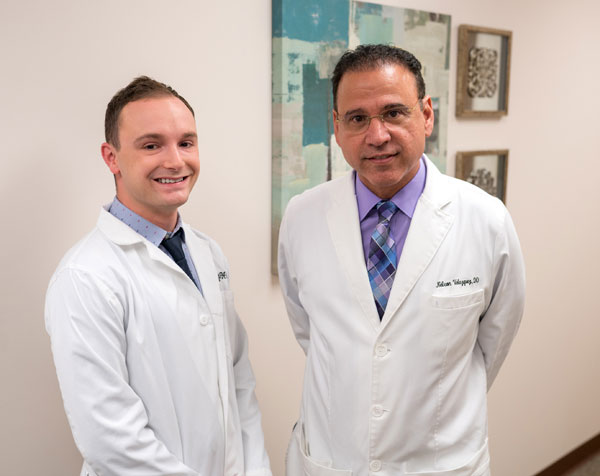Walking into the reception area filled with natural light coming thru the recessed ceiling, I am promptly greeted by a smiling front staff member who welcomes me on a tour of the office. Ducking my head into the exam rooms, I noticed the fresh décor and mounted computer screens displaying information on dermatologic topics. Plaques displayed by the checkout area express appreciation for a local team sponsorship and being chosen Best Dermatology Practice by The Journal. For a practice with seven offices, I am struck by the personal touch the Doctors and staff express to me and the patients in the office. This seems like a group that works well together and are happy with their live’s work.
Dr. Nelson Velazquez, takes time out of his busy day to meet with me. I ask how he choose to become a dermatologist, “Once I was accepted into Medical school, and exposed to the specialty of dermatology, I knew this was my calling. I liked that this specialty was a combination of a Medical and Surgical practice within one practice. I’ve been blessed to practice dermatology, and would do it all again.”

The practice specializes in medical and surgical dermatology, treating many skin conditions, ranging from skin cancer, eczema, psoriasis, acne, vitilago, cysts, and hair & nail disorders.
Much of the focus these days is on skin cancer. The three most common skin cancers are Basal Cell Carcinoma, Squamous Cell Carcinoma, and Melanoma.
Basal Cell carcinomas appear in many shapes and sizes. These appear on skin that gets repeated sun exposure such as the scalp, neck, and hands. It can also occur on the nose, cheeks, and forehead, but may also develop anywhere on the body. They may appear as a sore that does not heal, a dome shaped growth, or a shiny pinkish patch.
Squamous Cell carcinomas also develop on the skin that gets sun exposure or elsewhere on the body. They may appear as a bump that is crusty or rough, or a sore that does not heal. Some Squamous Cell carcinomas begin as actinic keratosis, which are a pre-cancerous lesion. They may be dry, scaly, and rough textured.
Melanoma, if detected early, is highly treatable. Like basal and squamous cell carcinomas, melanoma can be caused by sun exposure, but may also be caused by genetics. Research shows if a close blood relative had melanoma, a person has a much greater risk of getting melanoma themselves.
There are different modalities for treating skin cancer ranging from freezing the cancer cells with liquid nitrogen to a surgical procedure called Mohs surgery. With Mohs surgery, the procedure involves removing tissue in small amounts and then examined under a microscope while the patient remains in the operating suite. If there are any cancer cells remaining in the removed tissue, the Mohs surgeon continues to remove additional layers of tissue until there are no more cancer cells present. This ensures the cancer is removed entirely, but without removing healthy tissue along with it.
The practice also has its own in-office pathology laboratory and Board Certified Dermatopathologist, Dr. Adeel Ahmad. Tissue specimens are sent directly to the pathology laboratory located in the Beckley, WV Office for diagnosis. Biopsy results are usually returned within 1 week, in time for the patient who returns for follow-up after a biopsy.
I also met with Sean Gaffney.PA-C, who explained the importance of full body skin examinations. There is no set age for these annual skin checks to be done, but the teenage years are generally a good time to start annual full body skin checks. Many younger patients are being diagnosed with skin cancer due to genetics or tanning bed use. One in five Americans will develop skin cancer in their lifetime. Risk factors such as having a large number of moles, being of fair complexion, having a history of sunburns and/or tanning bed usage all factor in. Another risk is having an “ugly duckling mole”, one which looks different than other moles on the body. It is important to watch for any change in existing moles, such as growing or changing in diameter, bleeding, itching or changing in color. A way to remember your yearly skin check is to Check your birthday suit on your birthday.
Acne is the most common skin condition in the United States. Most are teenagers and young adults, but it can occur at any age, from newborns to menopausal women. Treatment can be topical medicine applied to the skin, or systemic treatment, which is a prescription that can treat larger areas of the body effected by acne. Some research does links one’s diet to trigger or worsen acne. Foods that cause high blood sugars, such as white bread and sugary snacks may worsen acne. Smoking also has been studied and found to make acne worse.
Other skin conditions such as eczema or psoriasis, a person may have a genetic disposition for it which may not show up until later in life. Stress and environmental factors may also cause the process to manifest itself. There are a number of ways to treat these conditions including UVB light therapy. The doctors also treat vitiligo, which is a condition where the skin loses its pigment in either small or large areas. Many patients with vitiligo develop symptoms by age 20. Research shows that about 20% of people with vitiligo have a blood relative with this condition. Light treatments, topical medicines along with other modes of care are options offered for vitiligo.
Protection from the sun’s harmful rays is of the utmost importance. SPF 30 or higher, which is water resistant, with a physical blocker such as zinc oxide or titanium dioxide are strongly advised. Sunscreen also needs to be applied 20 minutes prior to going outside, and reapplied every two hours. Wide brimmed hats, sunglasses and clothing with UV protection are also good barriers when fishing, golfing or being outdoors. Precautions and protection should be utilized year-round, and not only in the Summer months. Extra precaution is needed near water, snow and sand, as these reflect and intensify the damaging rays of the sun, which can increase the chance of sunburn.
Dermatology Associates & Surgery Center is physician owned and operated with their focus being on providing patients with accurate and prompt diagnosis and treatments for their skin conditions. The practice is a participating provider with most private medical insurances including Medicare and Medicaid. Referral from a doctor’s office is not mandatory but some health insurance providers do require a referral from a primary care physician. Dermatology Associates & Surgery Center’s goal is to see every new patient within a two week period. The practice accepts patients of all ages, from infant to the advanced in age. Dr. Velazquez is bi-lingual, which is helpful to Spanish speaking patients to better understand their conditions and treatment options, as well as make them feel more at ease while in the office. The doctors are Board Certified, with an ample staff of Certified Physician Assistants and Registered Nurses to ensure patients are treated promptly and with the utmost care. Continuing education for doctors and staff is ongoing so as to keep on the cutting edge of diagnosing and treating patients in the most state-of-the-art manner.
In addition to the office in Martinsburg, there are six offices throughout WV, and one in Hagerstown, MD. In our mobile society, this makes it convenient for patients to be treated in one or more of the offices within the practice. All patient records are electronic, which makes them accessible to all offices within the group. Office hours are Monday – Friday, 8:00AM – 5:00PM. The office keeps their phones open and available during lunch periods so as to be able to assist patients with appointments or any other needs that may arise during those busy times. There is always a doctor on call after hours that can be contacted after hours for emergent matters.
The Martinsburg Office is located at:
1000 Tavern Road
Martinsburg, WV 25401
304-350-8733
Website is: dascwc.com

